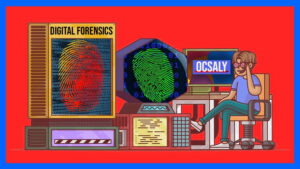If you’re interested in criminal investigations or forensic science, you may have heard of Locard’s Exchange Principle. This principle, developed by French criminologist Edmond Locard in the early 20th century, is a fundamental concept in forensic science that helps investigators connect evidence to suspects and crime scenes.
At its core, Locard’s Exchange Principle states that when two objects come into contact, they will exchange trace evidence. This means that any time a person enters a space or interacts with an object, they leave behind small pieces of themselves in the form of hair, skin cells, fibers, or other materials. Similarly, they may pick up trace evidence from the environment, such as soil, pollen, or fibers from clothing.
These tiny pieces of evidence, known as trace evidence or forensic evidence, can be analyzed and compared to other samples to determine whether there is a match. For example, if a suspect’s shoe leaves behind a distinctive tread pattern at a crime scene, investigators can use that evidence to link the suspect to the crime.
But Locard’s Exchange Principle isn’t just about physical evidence. It also applies to other types of evidence, such as digital evidence. When a person uses a computer or mobile device, they leave behind a digital trail that can be analyzed to determine what they did, when they did it, and how they did it. This digital evidence can be just as valuable in a criminal investigation as physical evidence.
In fact, Locard’s Exchange Principle is so fundamental to forensic science that it is often used to guide crime scene investigations. Investigators will carefully collect and analyze any trace evidence they find, looking for links between suspects, victims, and crime scenes. By following this principle, they can build a strong case against a suspect and increase the likelihood of a conviction.
Of course, there are limitations to Locard’s Exchange Principle. For example, trace evidence can degrade over time or be lost if it is not collected and analyzed promptly. Additionally, it can be difficult to determine exactly when and how evidence was transferred, which can make it challenging to build a complete picture of what happened.
Despite these limitations, Locard’s Exchange Principle remains a powerful tool in the field of forensic science. By understanding how evidence is transferred and analyzing the trace evidence left behind, investigators can piece together the puzzle of a crime and bring justice to victims and their families.
As I mentioned earlier, Locard’s Exchange Principle states that when two objects come into contact, they will exchange trace evidence. This means that any time a person enters a space or interacts with an object, they leave behind small pieces of themselves in the form of hair, skin cells, fibers, or other materials. Similarly, they may pick up trace evidence from the environment, such as soil, pollen, or fibers from clothing.
What makes Locard’s Exchange Principle so fascinating is that it applies to virtually every interaction between people and their environment. Whether we’re walking through a forest, typing on a computer, or touching a door handle, we’re leaving behind trace evidence that can be used to trace our movements and activities.
But it’s not just the ubiquity of trace evidence that makes Locard’s Exchange Principle so interesting. It’s also the fact that this principle has been used to solve countless crimes and mysteries over the years. From high-profile murder cases to complex financial fraud investigations, trace evidence has helped investigators piece together the puzzle of what happened and bring criminals to justice.
Of course, there are also challenges and limitations to working with trace evidence. It can be difficult to collect and analyze, and there are sometimes disputes over how to interpret the results. But despite these challenges, forensic scientists and investigators continue to rely on Locard’s Exchange Principle as a foundational concept in their work.
So if you’re interested in the science of criminal investigations, or you just want to learn more about the fascinating world of forensic science, be sure to check out our blog on Locard’s Exchange Principle. You’ll discover how this simple but powerful concept has helped solve some of the most intriguing and complex cases in history.









